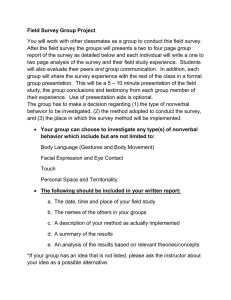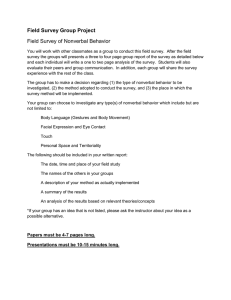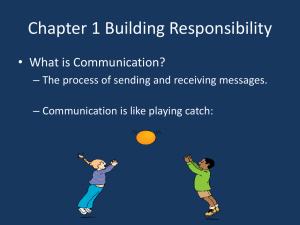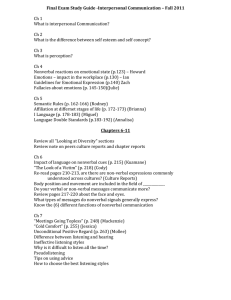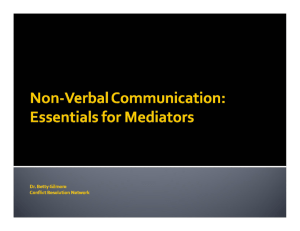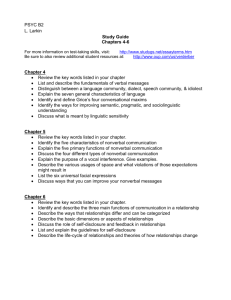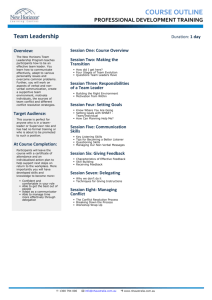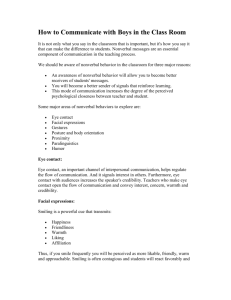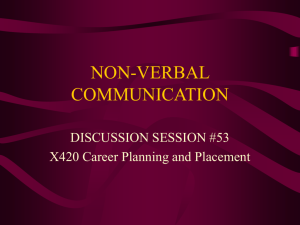4. Body Language and Posture
advertisement
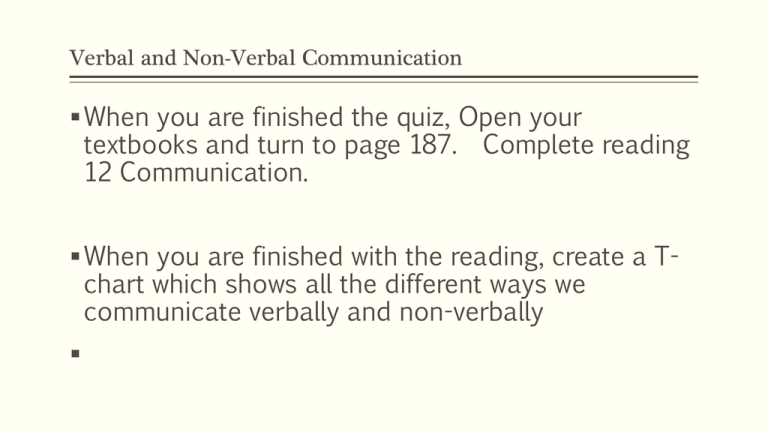
Verbal and Non-Verbal Communication When you are finished the quiz, Open your textbooks and turn to page 187. Complete reading 12 Communication. When you are finished with the reading, create a Tchart which shows all the different ways we communicate verbally and non-verbally Verbal and Non-Verbal Communication When you are finished with the reading, create a Tchart which shows all the different ways we communicate verbally and non-verbally NON-VERBAL COMMUNICATION 1. Facial Expression Facial expressions are responsible for a huge proportion of nonverbal communication. Consider how much information can be conveyed with a smile or a frown. While nonverbal communication and behavior can vary dramatically between cultures, the facial expressions for happiness, sadness, anger and fear are similar throughout the world. 2. Gestures Deliberate movements and signals are an important way to communicate meaning without words. Common gestures include waving, pointing, and using fingers to indicate numeric amounts. Other gestures are arbitrary and related to culture. 3. Paralinguistics Paralinguistics refers to vocal communication that is separate from actual language. This includes factors such as tone of voice, loudness, inflection and pitch. Consider the powerful effect that tone of voice can have on the meaning of a sentence. When said in a strong tone of voice, listeners might interpret approval and enthusiasm. The same words said in a hesitant tone of voice might convey disapproval and a lack of interest. 4. Body Language and Posture Posture and movement can also convey a great deal on information. Research on body language has grown significantly since the 1970's, but popular media have focused on the over-interpretation of defensive postures, arm-crossing, and leg-crossing, especially after the publication of Julius Fast's book Body Language. While these nonverbal behaviors can indicate feelings and attitudes, research suggests that body language is far more subtle and less definitive that previously believed. 5. Proxemics People often refer to their need for "personal space," which is also an important type of nonverbal communication. The amount of distance we need and the amount of space we perceive as belonging to us is influenced by a number of factors including social norms, situational factors, personality characteristics and level of familiarity. For example, the amount of personal space needed when having a casual conversation with another person usually varies between 18 inches to four feet. On the other hand, the personal distance needed when speaking to a crowd of people is around 10 to 12 feet. 6. Eye Gaze Looking, staring and blinking can also be important nonverbal behaviors. When people encounter people or things that they like, the rate of blinking increases and pupils dilate. Looking at another person can indicate a range of emotions, including hostility, interest and attraction. Haptics Communicating through touch is another important nonverbal behavior. There has been a substantial amount of research on the importance of touch in infancy and early childhood. Harry Harlow's classic monkey study demonstrated how the deprivation of touch and contact impedes development. Baby monkeys raised by wire mothers experienced permanent deficits in behavior and social interaction. Touch can be used to communicate affection, familiarity, sympathy and other emotions. 8. Appearance Our choice of color, clothing, hairstyles and other factors affecting appearance are also considered a means of nonverbal communication. Research on color psychology has demonstrated that different colors can evoke different moods. Appearance can also alter physiological reactions, judgments and interpretations. Just think of all the subtle judgements you quickly make about someone based on his or her appearance. These first impressions are important, which is why experts suggest that job seekers dress appropriately for interviews with potential employers.
